Leadership in Business: Transformative vs. Ethical Leadership Styles
VerifiedAdded on 2022/12/29
|12
|3332
|88
Essay
AI Summary
This essay delves into the critical role of leadership in business, emphasizing its impact on organizational success. It primarily focuses on two key leadership styles: transformative and ethical leadership. The essay analyzes the arguments of Caldwell et al. (2012) and Schaubroeck et al. (2012), exploring their underlying assumptions, values, and theoretical perspectives. It highlights how transformative leadership aims to inspire and create a vision, while ethical leadership emphasizes integrity and moral behavior across organizational levels. The analysis underscores the importance of behavior change in achieving desired outcomes, whether through radical transformations or the cascading of ethical cultures. The essay also examines the practical implications of these leadership styles, drawing on personal experiences and theoretical frameworks to illustrate how they influence employee behavior, organizational culture, and overall performance. Ultimately, the essay concludes that both transformative and ethical leadership are essential for fostering trust, driving innovation, and ensuring long-term organizational success in the modern business environment.
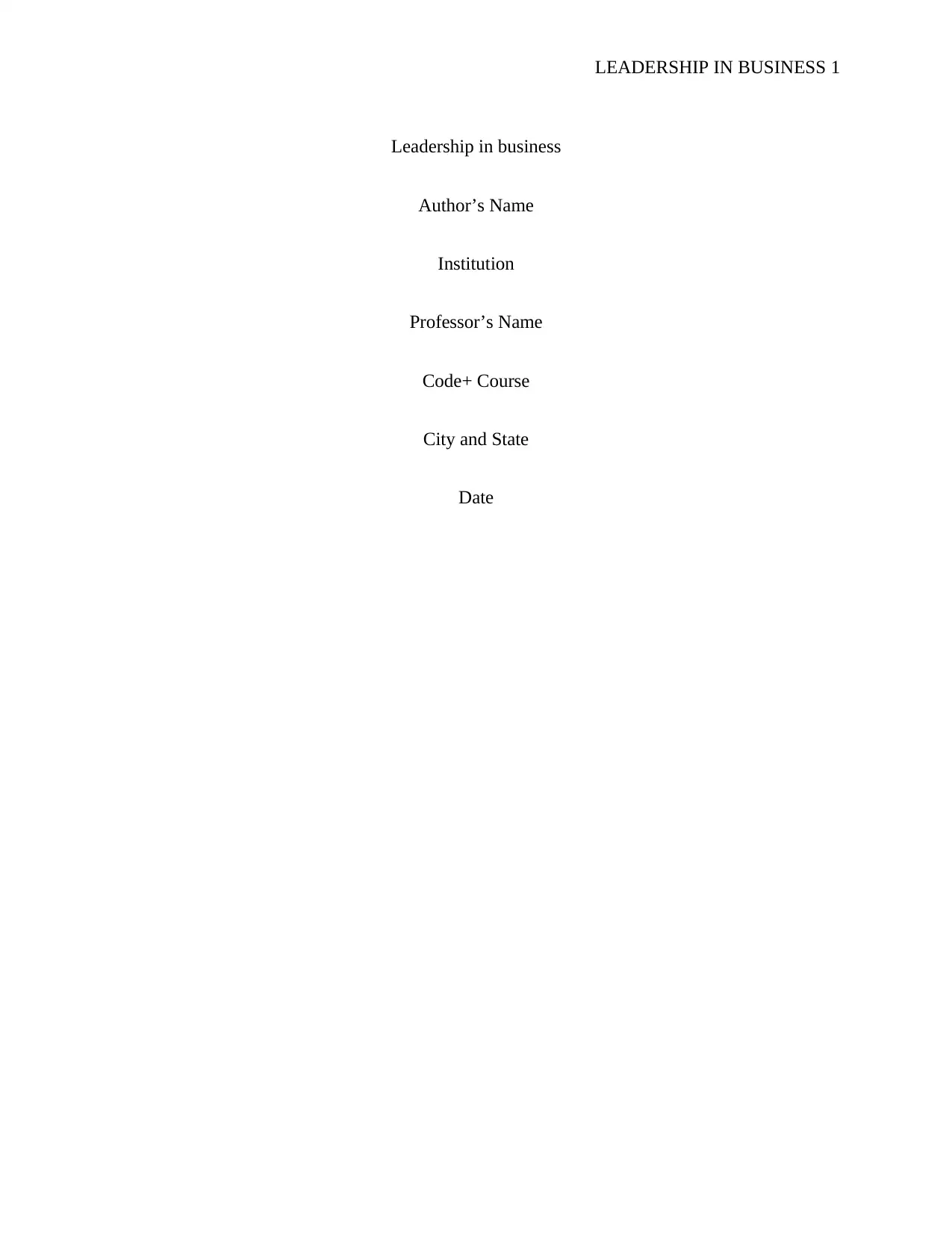
LEADERSHIP IN BUSINESS 1
Leadership in business
Author’s Name
Institution
Professor’s Name
Code+ Course
City and State
Date
Leadership in business
Author’s Name
Institution
Professor’s Name
Code+ Course
City and State
Date
Paraphrase This Document
Need a fresh take? Get an instant paraphrase of this document with our AI Paraphraser
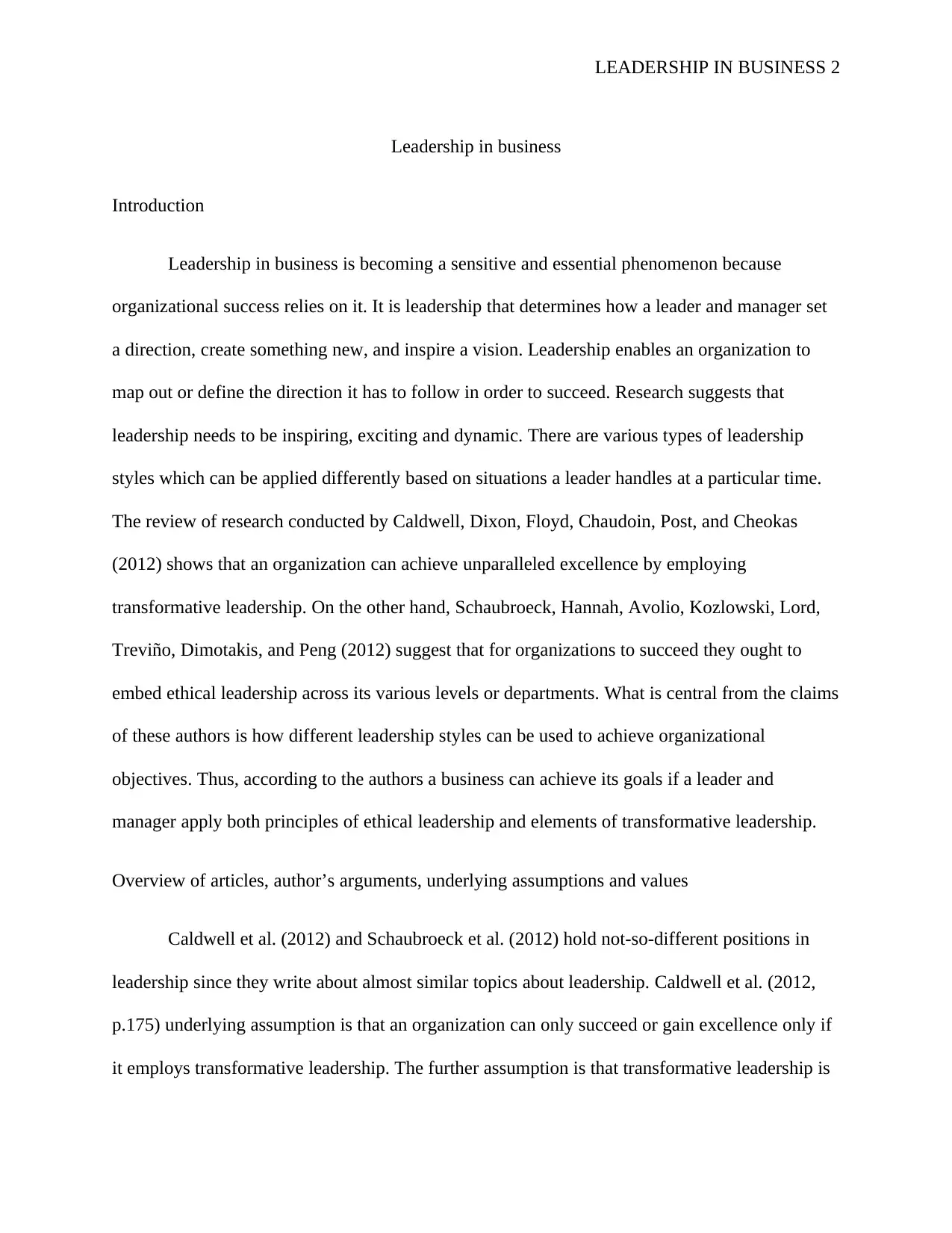
LEADERSHIP IN BUSINESS 2
Leadership in business
Introduction
Leadership in business is becoming a sensitive and essential phenomenon because
organizational success relies on it. It is leadership that determines how a leader and manager set
a direction, create something new, and inspire a vision. Leadership enables an organization to
map out or define the direction it has to follow in order to succeed. Research suggests that
leadership needs to be inspiring, exciting and dynamic. There are various types of leadership
styles which can be applied differently based on situations a leader handles at a particular time.
The review of research conducted by Caldwell, Dixon, Floyd, Chaudoin, Post, and Cheokas
(2012) shows that an organization can achieve unparalleled excellence by employing
transformative leadership. On the other hand, Schaubroeck, Hannah, Avolio, Kozlowski, Lord,
Treviño, Dimotakis, and Peng (2012) suggest that for organizations to succeed they ought to
embed ethical leadership across its various levels or departments. What is central from the claims
of these authors is how different leadership styles can be used to achieve organizational
objectives. Thus, according to the authors a business can achieve its goals if a leader and
manager apply both principles of ethical leadership and elements of transformative leadership.
Overview of articles, author’s arguments, underlying assumptions and values
Caldwell et al. (2012) and Schaubroeck et al. (2012) hold not-so-different positions in
leadership since they write about almost similar topics about leadership. Caldwell et al. (2012,
p.175) underlying assumption is that an organization can only succeed or gain excellence only if
it employs transformative leadership. The further assumption is that transformative leadership is
Leadership in business
Introduction
Leadership in business is becoming a sensitive and essential phenomenon because
organizational success relies on it. It is leadership that determines how a leader and manager set
a direction, create something new, and inspire a vision. Leadership enables an organization to
map out or define the direction it has to follow in order to succeed. Research suggests that
leadership needs to be inspiring, exciting and dynamic. There are various types of leadership
styles which can be applied differently based on situations a leader handles at a particular time.
The review of research conducted by Caldwell, Dixon, Floyd, Chaudoin, Post, and Cheokas
(2012) shows that an organization can achieve unparalleled excellence by employing
transformative leadership. On the other hand, Schaubroeck, Hannah, Avolio, Kozlowski, Lord,
Treviño, Dimotakis, and Peng (2012) suggest that for organizations to succeed they ought to
embed ethical leadership across its various levels or departments. What is central from the claims
of these authors is how different leadership styles can be used to achieve organizational
objectives. Thus, according to the authors a business can achieve its goals if a leader and
manager apply both principles of ethical leadership and elements of transformative leadership.
Overview of articles, author’s arguments, underlying assumptions and values
Caldwell et al. (2012) and Schaubroeck et al. (2012) hold not-so-different positions in
leadership since they write about almost similar topics about leadership. Caldwell et al. (2012,
p.175) underlying assumption is that an organization can only succeed or gain excellence only if
it employs transformative leadership. The further assumption is that transformative leadership is
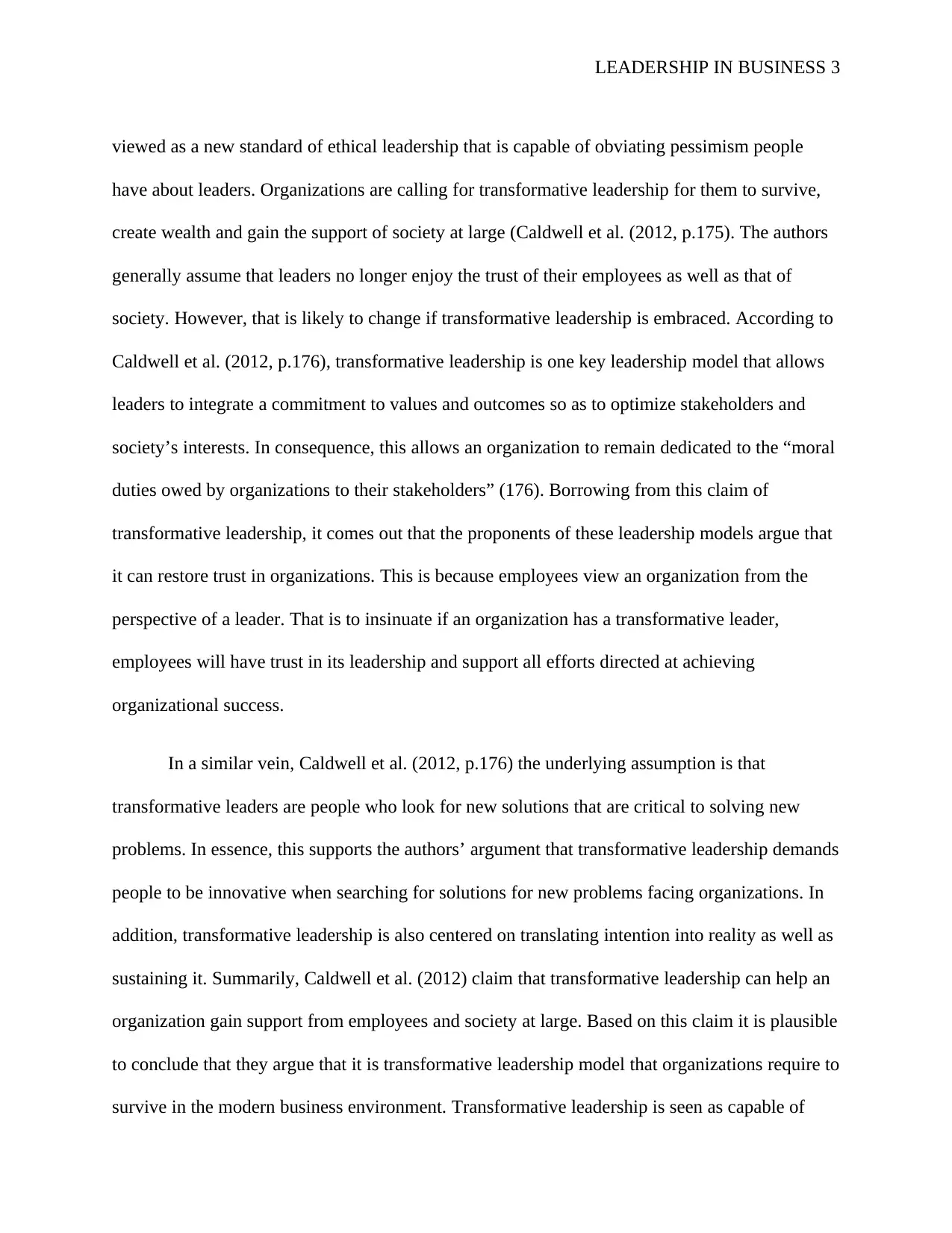
LEADERSHIP IN BUSINESS 3
viewed as a new standard of ethical leadership that is capable of obviating pessimism people
have about leaders. Organizations are calling for transformative leadership for them to survive,
create wealth and gain the support of society at large (Caldwell et al. (2012, p.175). The authors
generally assume that leaders no longer enjoy the trust of their employees as well as that of
society. However, that is likely to change if transformative leadership is embraced. According to
Caldwell et al. (2012, p.176), transformative leadership is one key leadership model that allows
leaders to integrate a commitment to values and outcomes so as to optimize stakeholders and
society’s interests. In consequence, this allows an organization to remain dedicated to the “moral
duties owed by organizations to their stakeholders” (176). Borrowing from this claim of
transformative leadership, it comes out that the proponents of these leadership models argue that
it can restore trust in organizations. This is because employees view an organization from the
perspective of a leader. That is to insinuate if an organization has a transformative leader,
employees will have trust in its leadership and support all efforts directed at achieving
organizational success.
In a similar vein, Caldwell et al. (2012, p.176) the underlying assumption is that
transformative leaders are people who look for new solutions that are critical to solving new
problems. In essence, this supports the authors’ argument that transformative leadership demands
people to be innovative when searching for solutions for new problems facing organizations. In
addition, transformative leadership is also centered on translating intention into reality as well as
sustaining it. Summarily, Caldwell et al. (2012) claim that transformative leadership can help an
organization gain support from employees and society at large. Based on this claim it is plausible
to conclude that they argue that it is transformative leadership model that organizations require to
survive in the modern business environment. Transformative leadership is seen as capable of
viewed as a new standard of ethical leadership that is capable of obviating pessimism people
have about leaders. Organizations are calling for transformative leadership for them to survive,
create wealth and gain the support of society at large (Caldwell et al. (2012, p.175). The authors
generally assume that leaders no longer enjoy the trust of their employees as well as that of
society. However, that is likely to change if transformative leadership is embraced. According to
Caldwell et al. (2012, p.176), transformative leadership is one key leadership model that allows
leaders to integrate a commitment to values and outcomes so as to optimize stakeholders and
society’s interests. In consequence, this allows an organization to remain dedicated to the “moral
duties owed by organizations to their stakeholders” (176). Borrowing from this claim of
transformative leadership, it comes out that the proponents of these leadership models argue that
it can restore trust in organizations. This is because employees view an organization from the
perspective of a leader. That is to insinuate if an organization has a transformative leader,
employees will have trust in its leadership and support all efforts directed at achieving
organizational success.
In a similar vein, Caldwell et al. (2012, p.176) the underlying assumption is that
transformative leaders are people who look for new solutions that are critical to solving new
problems. In essence, this supports the authors’ argument that transformative leadership demands
people to be innovative when searching for solutions for new problems facing organizations. In
addition, transformative leadership is also centered on translating intention into reality as well as
sustaining it. Summarily, Caldwell et al. (2012) claim that transformative leadership can help an
organization gain support from employees and society at large. Based on this claim it is plausible
to conclude that they argue that it is transformative leadership model that organizations require to
survive in the modern business environment. Transformative leadership is seen as capable of
⊘ This is a preview!⊘
Do you want full access?
Subscribe today to unlock all pages.

Trusted by 1+ million students worldwide
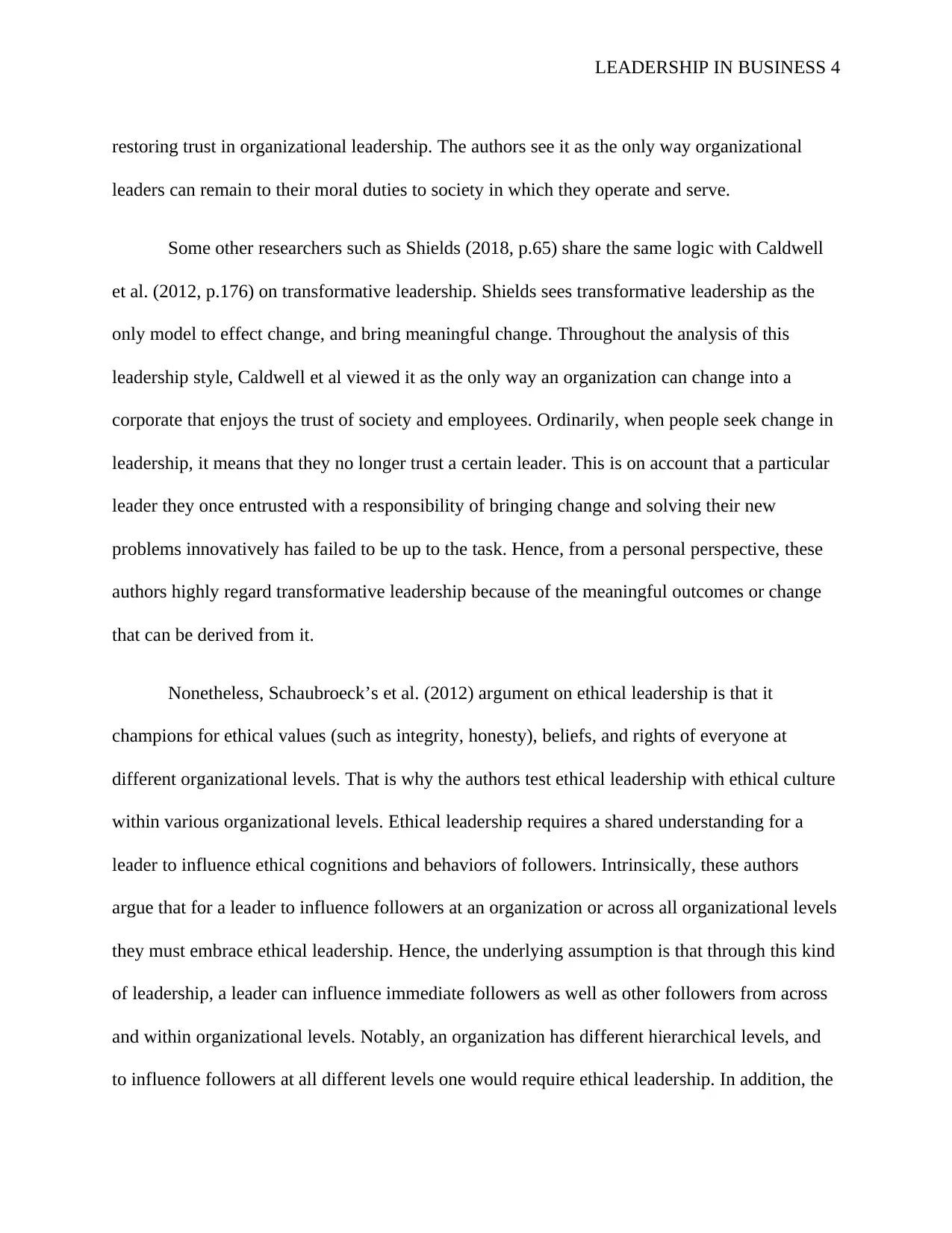
LEADERSHIP IN BUSINESS 4
restoring trust in organizational leadership. The authors see it as the only way organizational
leaders can remain to their moral duties to society in which they operate and serve.
Some other researchers such as Shields (2018, p.65) share the same logic with Caldwell
et al. (2012, p.176) on transformative leadership. Shields sees transformative leadership as the
only model to effect change, and bring meaningful change. Throughout the analysis of this
leadership style, Caldwell et al viewed it as the only way an organization can change into a
corporate that enjoys the trust of society and employees. Ordinarily, when people seek change in
leadership, it means that they no longer trust a certain leader. This is on account that a particular
leader they once entrusted with a responsibility of bringing change and solving their new
problems innovatively has failed to be up to the task. Hence, from a personal perspective, these
authors highly regard transformative leadership because of the meaningful outcomes or change
that can be derived from it.
Nonetheless, Schaubroeck’s et al. (2012) argument on ethical leadership is that it
champions for ethical values (such as integrity, honesty), beliefs, and rights of everyone at
different organizational levels. That is why the authors test ethical leadership with ethical culture
within various organizational levels. Ethical leadership requires a shared understanding for a
leader to influence ethical cognitions and behaviors of followers. Intrinsically, these authors
argue that for a leader to influence followers at an organization or across all organizational levels
they must embrace ethical leadership. Hence, the underlying assumption is that through this kind
of leadership, a leader can influence immediate followers as well as other followers from across
and within organizational levels. Notably, an organization has different hierarchical levels, and
to influence followers at all different levels one would require ethical leadership. In addition, the
restoring trust in organizational leadership. The authors see it as the only way organizational
leaders can remain to their moral duties to society in which they operate and serve.
Some other researchers such as Shields (2018, p.65) share the same logic with Caldwell
et al. (2012, p.176) on transformative leadership. Shields sees transformative leadership as the
only model to effect change, and bring meaningful change. Throughout the analysis of this
leadership style, Caldwell et al viewed it as the only way an organization can change into a
corporate that enjoys the trust of society and employees. Ordinarily, when people seek change in
leadership, it means that they no longer trust a certain leader. This is on account that a particular
leader they once entrusted with a responsibility of bringing change and solving their new
problems innovatively has failed to be up to the task. Hence, from a personal perspective, these
authors highly regard transformative leadership because of the meaningful outcomes or change
that can be derived from it.
Nonetheless, Schaubroeck’s et al. (2012) argument on ethical leadership is that it
champions for ethical values (such as integrity, honesty), beliefs, and rights of everyone at
different organizational levels. That is why the authors test ethical leadership with ethical culture
within various organizational levels. Ethical leadership requires a shared understanding for a
leader to influence ethical cognitions and behaviors of followers. Intrinsically, these authors
argue that for a leader to influence followers at an organization or across all organizational levels
they must embrace ethical leadership. Hence, the underlying assumption is that through this kind
of leadership, a leader can influence immediate followers as well as other followers from across
and within organizational levels. Notably, an organization has different hierarchical levels, and
to influence followers at all different levels one would require ethical leadership. In addition, the
Paraphrase This Document
Need a fresh take? Get an instant paraphrase of this document with our AI Paraphraser
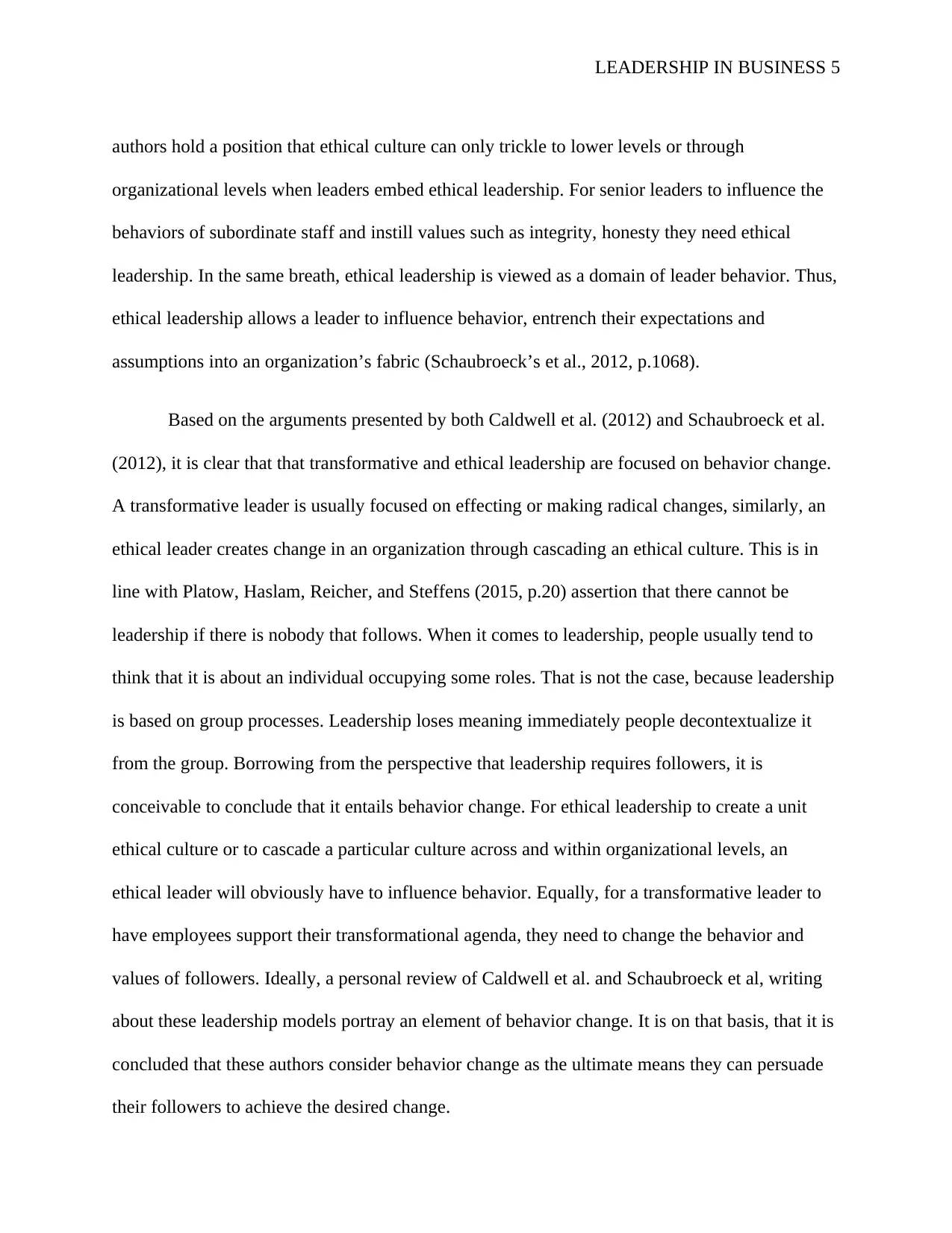
LEADERSHIP IN BUSINESS 5
authors hold a position that ethical culture can only trickle to lower levels or through
organizational levels when leaders embed ethical leadership. For senior leaders to influence the
behaviors of subordinate staff and instill values such as integrity, honesty they need ethical
leadership. In the same breath, ethical leadership is viewed as a domain of leader behavior. Thus,
ethical leadership allows a leader to influence behavior, entrench their expectations and
assumptions into an organization’s fabric (Schaubroeck’s et al., 2012, p.1068).
Based on the arguments presented by both Caldwell et al. (2012) and Schaubroeck et al.
(2012), it is clear that that transformative and ethical leadership are focused on behavior change.
A transformative leader is usually focused on effecting or making radical changes, similarly, an
ethical leader creates change in an organization through cascading an ethical culture. This is in
line with Platow, Haslam, Reicher, and Steffens (2015, p.20) assertion that there cannot be
leadership if there is nobody that follows. When it comes to leadership, people usually tend to
think that it is about an individual occupying some roles. That is not the case, because leadership
is based on group processes. Leadership loses meaning immediately people decontextualize it
from the group. Borrowing from the perspective that leadership requires followers, it is
conceivable to conclude that it entails behavior change. For ethical leadership to create a unit
ethical culture or to cascade a particular culture across and within organizational levels, an
ethical leader will obviously have to influence behavior. Equally, for a transformative leader to
have employees support their transformational agenda, they need to change the behavior and
values of followers. Ideally, a personal review of Caldwell et al. and Schaubroeck et al, writing
about these leadership models portray an element of behavior change. It is on that basis, that it is
concluded that these authors consider behavior change as the ultimate means they can persuade
their followers to achieve the desired change.
authors hold a position that ethical culture can only trickle to lower levels or through
organizational levels when leaders embed ethical leadership. For senior leaders to influence the
behaviors of subordinate staff and instill values such as integrity, honesty they need ethical
leadership. In the same breath, ethical leadership is viewed as a domain of leader behavior. Thus,
ethical leadership allows a leader to influence behavior, entrench their expectations and
assumptions into an organization’s fabric (Schaubroeck’s et al., 2012, p.1068).
Based on the arguments presented by both Caldwell et al. (2012) and Schaubroeck et al.
(2012), it is clear that that transformative and ethical leadership are focused on behavior change.
A transformative leader is usually focused on effecting or making radical changes, similarly, an
ethical leader creates change in an organization through cascading an ethical culture. This is in
line with Platow, Haslam, Reicher, and Steffens (2015, p.20) assertion that there cannot be
leadership if there is nobody that follows. When it comes to leadership, people usually tend to
think that it is about an individual occupying some roles. That is not the case, because leadership
is based on group processes. Leadership loses meaning immediately people decontextualize it
from the group. Borrowing from the perspective that leadership requires followers, it is
conceivable to conclude that it entails behavior change. For ethical leadership to create a unit
ethical culture or to cascade a particular culture across and within organizational levels, an
ethical leader will obviously have to influence behavior. Equally, for a transformative leader to
have employees support their transformational agenda, they need to change the behavior and
values of followers. Ideally, a personal review of Caldwell et al. and Schaubroeck et al, writing
about these leadership models portray an element of behavior change. It is on that basis, that it is
concluded that these authors consider behavior change as the ultimate means they can persuade
their followers to achieve the desired change.
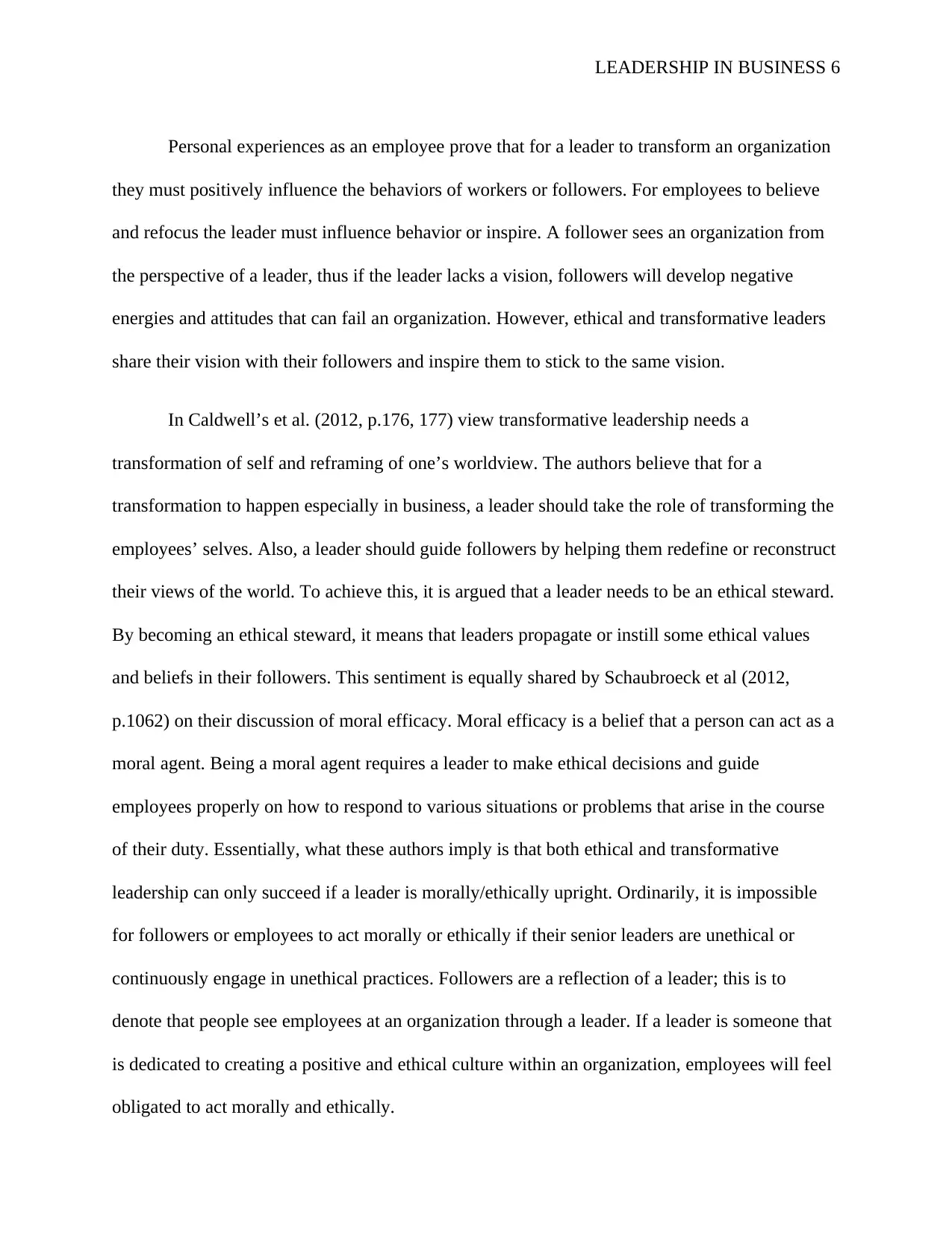
LEADERSHIP IN BUSINESS 6
Personal experiences as an employee prove that for a leader to transform an organization
they must positively influence the behaviors of workers or followers. For employees to believe
and refocus the leader must influence behavior or inspire. A follower sees an organization from
the perspective of a leader, thus if the leader lacks a vision, followers will develop negative
energies and attitudes that can fail an organization. However, ethical and transformative leaders
share their vision with their followers and inspire them to stick to the same vision.
In Caldwell’s et al. (2012, p.176, 177) view transformative leadership needs a
transformation of self and reframing of one’s worldview. The authors believe that for a
transformation to happen especially in business, a leader should take the role of transforming the
employees’ selves. Also, a leader should guide followers by helping them redefine or reconstruct
their views of the world. To achieve this, it is argued that a leader needs to be an ethical steward.
By becoming an ethical steward, it means that leaders propagate or instill some ethical values
and beliefs in their followers. This sentiment is equally shared by Schaubroeck et al (2012,
p.1062) on their discussion of moral efficacy. Moral efficacy is a belief that a person can act as a
moral agent. Being a moral agent requires a leader to make ethical decisions and guide
employees properly on how to respond to various situations or problems that arise in the course
of their duty. Essentially, what these authors imply is that both ethical and transformative
leadership can only succeed if a leader is morally/ethically upright. Ordinarily, it is impossible
for followers or employees to act morally or ethically if their senior leaders are unethical or
continuously engage in unethical practices. Followers are a reflection of a leader; this is to
denote that people see employees at an organization through a leader. If a leader is someone that
is dedicated to creating a positive and ethical culture within an organization, employees will feel
obligated to act morally and ethically.
Personal experiences as an employee prove that for a leader to transform an organization
they must positively influence the behaviors of workers or followers. For employees to believe
and refocus the leader must influence behavior or inspire. A follower sees an organization from
the perspective of a leader, thus if the leader lacks a vision, followers will develop negative
energies and attitudes that can fail an organization. However, ethical and transformative leaders
share their vision with their followers and inspire them to stick to the same vision.
In Caldwell’s et al. (2012, p.176, 177) view transformative leadership needs a
transformation of self and reframing of one’s worldview. The authors believe that for a
transformation to happen especially in business, a leader should take the role of transforming the
employees’ selves. Also, a leader should guide followers by helping them redefine or reconstruct
their views of the world. To achieve this, it is argued that a leader needs to be an ethical steward.
By becoming an ethical steward, it means that leaders propagate or instill some ethical values
and beliefs in their followers. This sentiment is equally shared by Schaubroeck et al (2012,
p.1062) on their discussion of moral efficacy. Moral efficacy is a belief that a person can act as a
moral agent. Being a moral agent requires a leader to make ethical decisions and guide
employees properly on how to respond to various situations or problems that arise in the course
of their duty. Essentially, what these authors imply is that both ethical and transformative
leadership can only succeed if a leader is morally/ethically upright. Ordinarily, it is impossible
for followers or employees to act morally or ethically if their senior leaders are unethical or
continuously engage in unethical practices. Followers are a reflection of a leader; this is to
denote that people see employees at an organization through a leader. If a leader is someone that
is dedicated to creating a positive and ethical culture within an organization, employees will feel
obligated to act morally and ethically.
⊘ This is a preview!⊘
Do you want full access?
Subscribe today to unlock all pages.

Trusted by 1+ million students worldwide
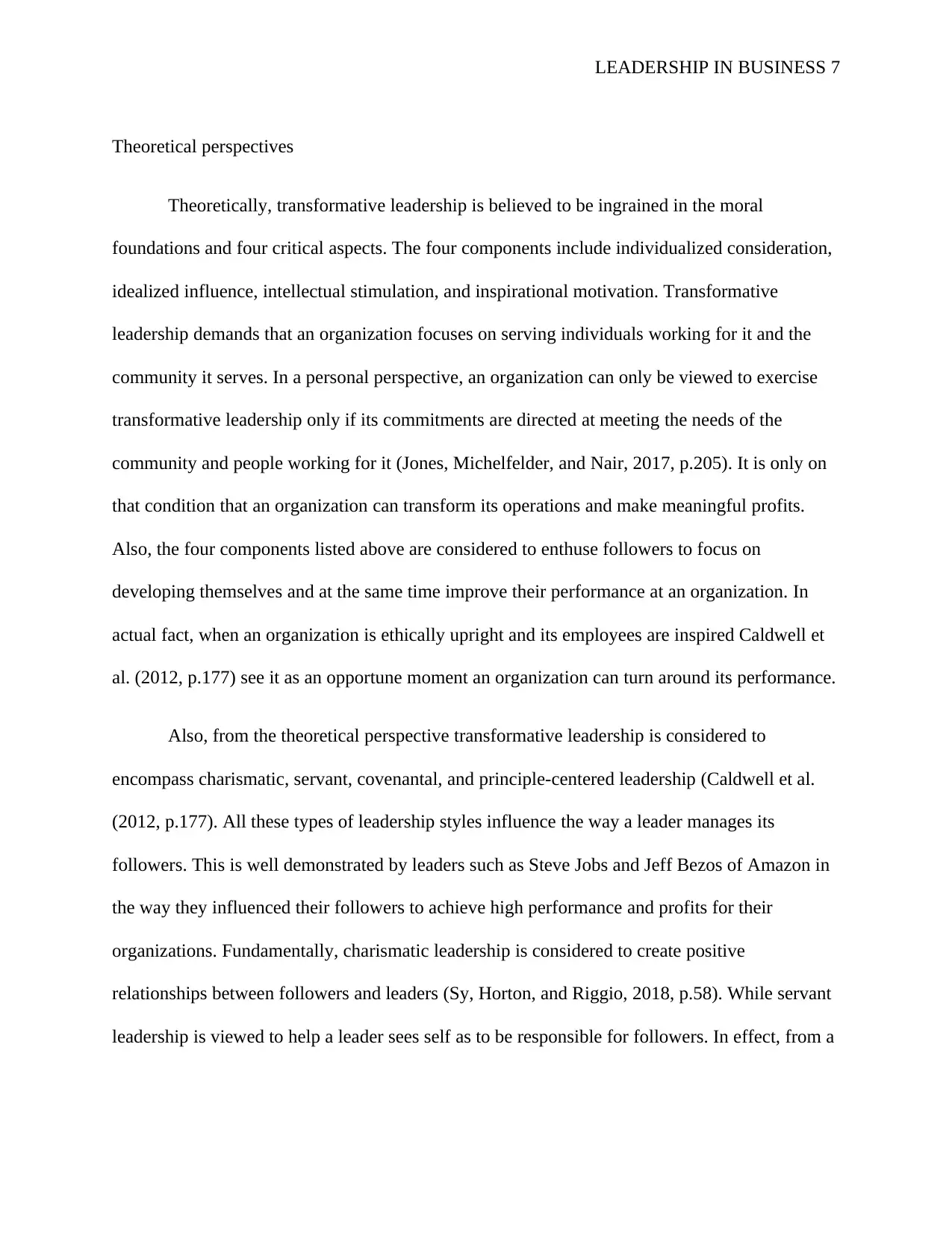
LEADERSHIP IN BUSINESS 7
Theoretical perspectives
Theoretically, transformative leadership is believed to be ingrained in the moral
foundations and four critical aspects. The four components include individualized consideration,
idealized influence, intellectual stimulation, and inspirational motivation. Transformative
leadership demands that an organization focuses on serving individuals working for it and the
community it serves. In a personal perspective, an organization can only be viewed to exercise
transformative leadership only if its commitments are directed at meeting the needs of the
community and people working for it (Jones, Michelfelder, and Nair, 2017, p.205). It is only on
that condition that an organization can transform its operations and make meaningful profits.
Also, the four components listed above are considered to enthuse followers to focus on
developing themselves and at the same time improve their performance at an organization. In
actual fact, when an organization is ethically upright and its employees are inspired Caldwell et
al. (2012, p.177) see it as an opportune moment an organization can turn around its performance.
Also, from the theoretical perspective transformative leadership is considered to
encompass charismatic, servant, covenantal, and principle-centered leadership (Caldwell et al.
(2012, p.177). All these types of leadership styles influence the way a leader manages its
followers. This is well demonstrated by leaders such as Steve Jobs and Jeff Bezos of Amazon in
the way they influenced their followers to achieve high performance and profits for their
organizations. Fundamentally, charismatic leadership is considered to create positive
relationships between followers and leaders (Sy, Horton, and Riggio, 2018, p.58). While servant
leadership is viewed to help a leader sees self as to be responsible for followers. In effect, from a
Theoretical perspectives
Theoretically, transformative leadership is believed to be ingrained in the moral
foundations and four critical aspects. The four components include individualized consideration,
idealized influence, intellectual stimulation, and inspirational motivation. Transformative
leadership demands that an organization focuses on serving individuals working for it and the
community it serves. In a personal perspective, an organization can only be viewed to exercise
transformative leadership only if its commitments are directed at meeting the needs of the
community and people working for it (Jones, Michelfelder, and Nair, 2017, p.205). It is only on
that condition that an organization can transform its operations and make meaningful profits.
Also, the four components listed above are considered to enthuse followers to focus on
developing themselves and at the same time improve their performance at an organization. In
actual fact, when an organization is ethically upright and its employees are inspired Caldwell et
al. (2012, p.177) see it as an opportune moment an organization can turn around its performance.
Also, from the theoretical perspective transformative leadership is considered to
encompass charismatic, servant, covenantal, and principle-centered leadership (Caldwell et al.
(2012, p.177). All these types of leadership styles influence the way a leader manages its
followers. This is well demonstrated by leaders such as Steve Jobs and Jeff Bezos of Amazon in
the way they influenced their followers to achieve high performance and profits for their
organizations. Fundamentally, charismatic leadership is considered to create positive
relationships between followers and leaders (Sy, Horton, and Riggio, 2018, p.58). While servant
leadership is viewed to help a leader sees self as to be responsible for followers. In effect, from a
Paraphrase This Document
Need a fresh take? Get an instant paraphrase of this document with our AI Paraphraser
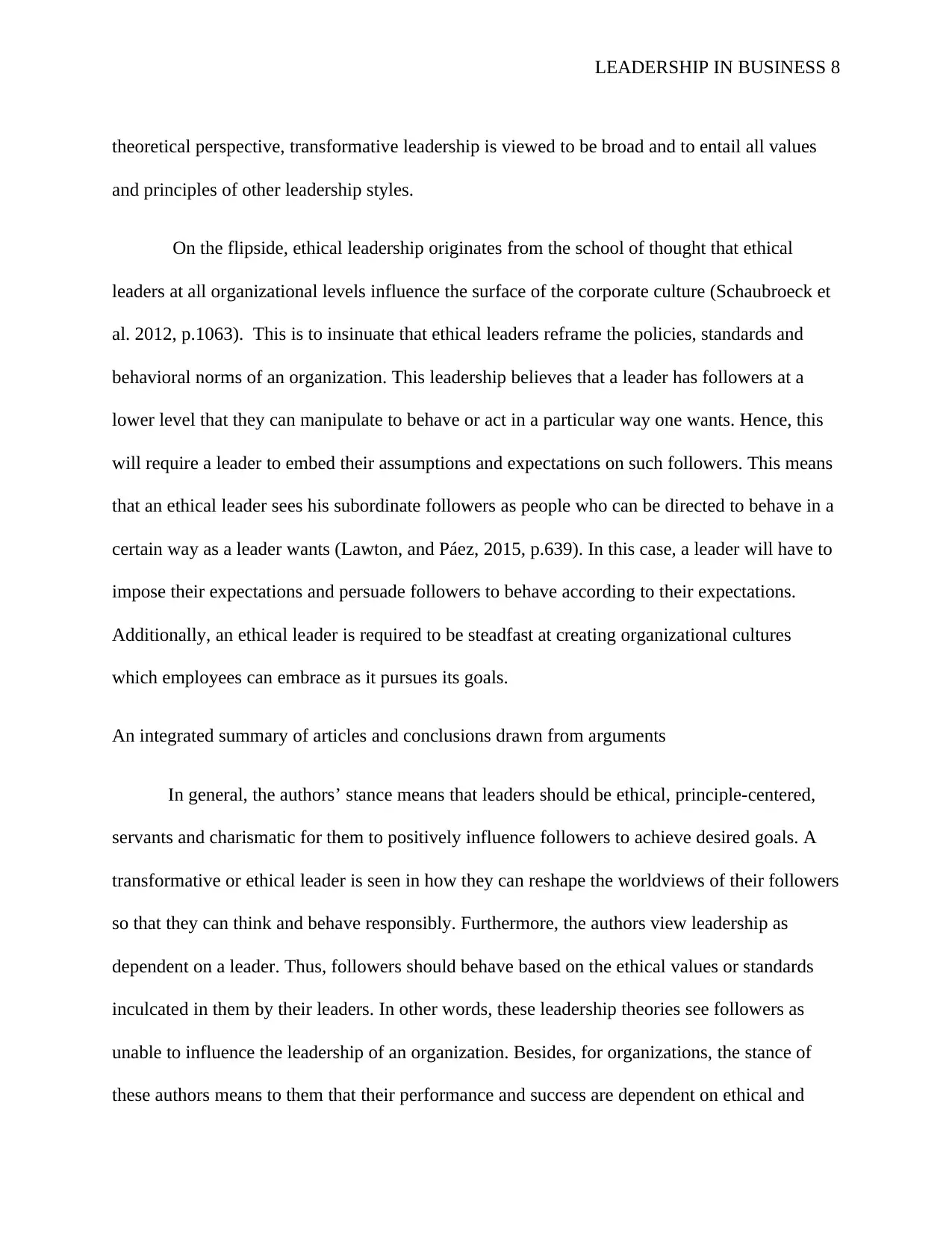
LEADERSHIP IN BUSINESS 8
theoretical perspective, transformative leadership is viewed to be broad and to entail all values
and principles of other leadership styles.
On the flipside, ethical leadership originates from the school of thought that ethical
leaders at all organizational levels influence the surface of the corporate culture (Schaubroeck et
al. 2012, p.1063). This is to insinuate that ethical leaders reframe the policies, standards and
behavioral norms of an organization. This leadership believes that a leader has followers at a
lower level that they can manipulate to behave or act in a particular way one wants. Hence, this
will require a leader to embed their assumptions and expectations on such followers. This means
that an ethical leader sees his subordinate followers as people who can be directed to behave in a
certain way as a leader wants (Lawton, and Páez, 2015, p.639). In this case, a leader will have to
impose their expectations and persuade followers to behave according to their expectations.
Additionally, an ethical leader is required to be steadfast at creating organizational cultures
which employees can embrace as it pursues its goals.
An integrated summary of articles and conclusions drawn from arguments
In general, the authors’ stance means that leaders should be ethical, principle-centered,
servants and charismatic for them to positively influence followers to achieve desired goals. A
transformative or ethical leader is seen in how they can reshape the worldviews of their followers
so that they can think and behave responsibly. Furthermore, the authors view leadership as
dependent on a leader. Thus, followers should behave based on the ethical values or standards
inculcated in them by their leaders. In other words, these leadership theories see followers as
unable to influence the leadership of an organization. Besides, for organizations, the stance of
these authors means to them that their performance and success are dependent on ethical and
theoretical perspective, transformative leadership is viewed to be broad and to entail all values
and principles of other leadership styles.
On the flipside, ethical leadership originates from the school of thought that ethical
leaders at all organizational levels influence the surface of the corporate culture (Schaubroeck et
al. 2012, p.1063). This is to insinuate that ethical leaders reframe the policies, standards and
behavioral norms of an organization. This leadership believes that a leader has followers at a
lower level that they can manipulate to behave or act in a particular way one wants. Hence, this
will require a leader to embed their assumptions and expectations on such followers. This means
that an ethical leader sees his subordinate followers as people who can be directed to behave in a
certain way as a leader wants (Lawton, and Páez, 2015, p.639). In this case, a leader will have to
impose their expectations and persuade followers to behave according to their expectations.
Additionally, an ethical leader is required to be steadfast at creating organizational cultures
which employees can embrace as it pursues its goals.
An integrated summary of articles and conclusions drawn from arguments
In general, the authors’ stance means that leaders should be ethical, principle-centered,
servants and charismatic for them to positively influence followers to achieve desired goals. A
transformative or ethical leader is seen in how they can reshape the worldviews of their followers
so that they can think and behave responsibly. Furthermore, the authors view leadership as
dependent on a leader. Thus, followers should behave based on the ethical values or standards
inculcated in them by their leaders. In other words, these leadership theories see followers as
unable to influence the leadership of an organization. Besides, for organizations, the stance of
these authors means to them that their performance and success are dependent on ethical and
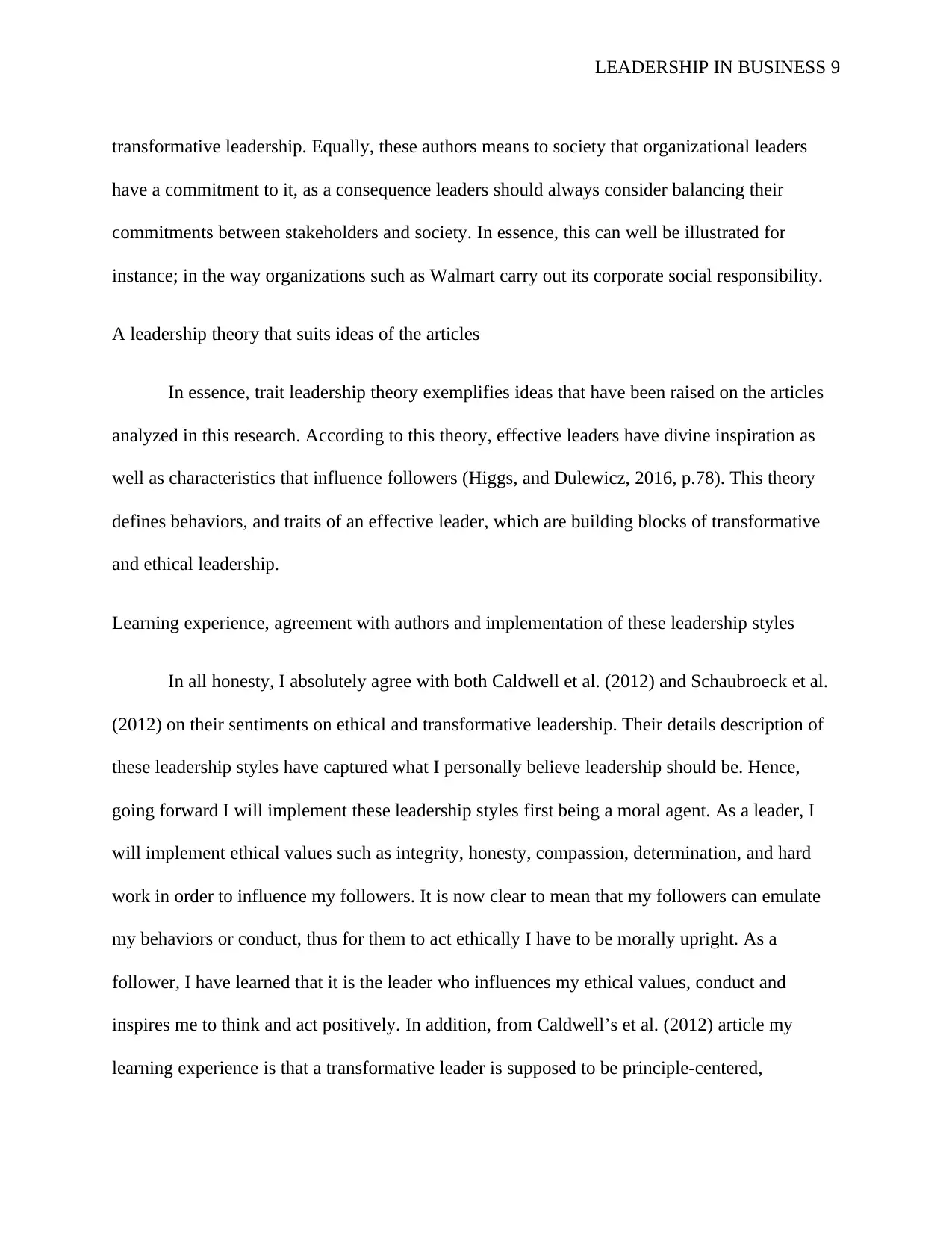
LEADERSHIP IN BUSINESS 9
transformative leadership. Equally, these authors means to society that organizational leaders
have a commitment to it, as a consequence leaders should always consider balancing their
commitments between stakeholders and society. In essence, this can well be illustrated for
instance; in the way organizations such as Walmart carry out its corporate social responsibility.
A leadership theory that suits ideas of the articles
In essence, trait leadership theory exemplifies ideas that have been raised on the articles
analyzed in this research. According to this theory, effective leaders have divine inspiration as
well as characteristics that influence followers (Higgs, and Dulewicz, 2016, p.78). This theory
defines behaviors, and traits of an effective leader, which are building blocks of transformative
and ethical leadership.
Learning experience, agreement with authors and implementation of these leadership styles
In all honesty, I absolutely agree with both Caldwell et al. (2012) and Schaubroeck et al.
(2012) on their sentiments on ethical and transformative leadership. Their details description of
these leadership styles have captured what I personally believe leadership should be. Hence,
going forward I will implement these leadership styles first being a moral agent. As a leader, I
will implement ethical values such as integrity, honesty, compassion, determination, and hard
work in order to influence my followers. It is now clear to mean that my followers can emulate
my behaviors or conduct, thus for them to act ethically I have to be morally upright. As a
follower, I have learned that it is the leader who influences my ethical values, conduct and
inspires me to think and act positively. In addition, from Caldwell’s et al. (2012) article my
learning experience is that a transformative leader is supposed to be principle-centered,
transformative leadership. Equally, these authors means to society that organizational leaders
have a commitment to it, as a consequence leaders should always consider balancing their
commitments between stakeholders and society. In essence, this can well be illustrated for
instance; in the way organizations such as Walmart carry out its corporate social responsibility.
A leadership theory that suits ideas of the articles
In essence, trait leadership theory exemplifies ideas that have been raised on the articles
analyzed in this research. According to this theory, effective leaders have divine inspiration as
well as characteristics that influence followers (Higgs, and Dulewicz, 2016, p.78). This theory
defines behaviors, and traits of an effective leader, which are building blocks of transformative
and ethical leadership.
Learning experience, agreement with authors and implementation of these leadership styles
In all honesty, I absolutely agree with both Caldwell et al. (2012) and Schaubroeck et al.
(2012) on their sentiments on ethical and transformative leadership. Their details description of
these leadership styles have captured what I personally believe leadership should be. Hence,
going forward I will implement these leadership styles first being a moral agent. As a leader, I
will implement ethical values such as integrity, honesty, compassion, determination, and hard
work in order to influence my followers. It is now clear to mean that my followers can emulate
my behaviors or conduct, thus for them to act ethically I have to be morally upright. As a
follower, I have learned that it is the leader who influences my ethical values, conduct and
inspires me to think and act positively. In addition, from Caldwell’s et al. (2012) article my
learning experience is that a transformative leader is supposed to be principle-centered,
⊘ This is a preview!⊘
Do you want full access?
Subscribe today to unlock all pages.

Trusted by 1+ million students worldwide
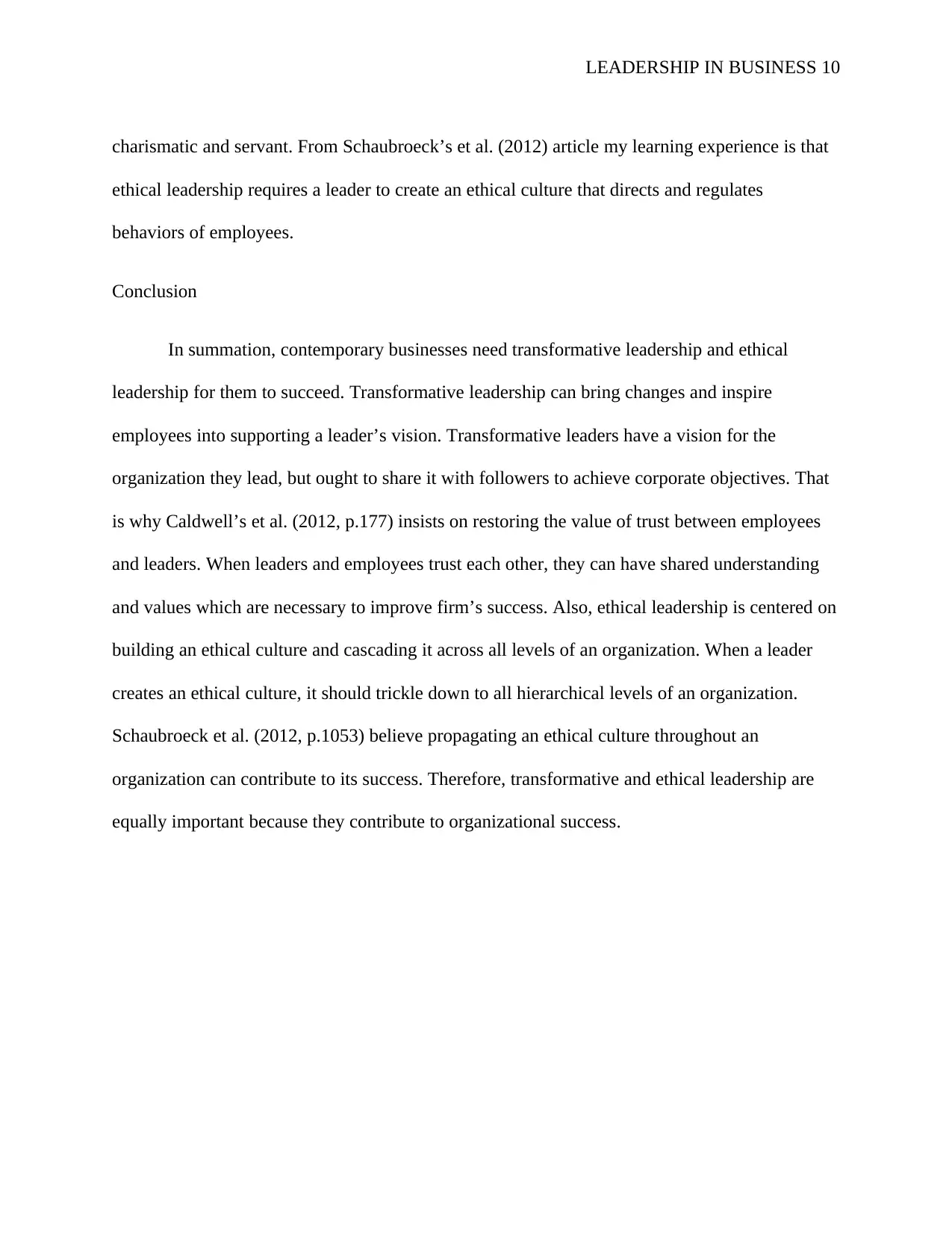
LEADERSHIP IN BUSINESS 10
charismatic and servant. From Schaubroeck’s et al. (2012) article my learning experience is that
ethical leadership requires a leader to create an ethical culture that directs and regulates
behaviors of employees.
Conclusion
In summation, contemporary businesses need transformative leadership and ethical
leadership for them to succeed. Transformative leadership can bring changes and inspire
employees into supporting a leader’s vision. Transformative leaders have a vision for the
organization they lead, but ought to share it with followers to achieve corporate objectives. That
is why Caldwell’s et al. (2012, p.177) insists on restoring the value of trust between employees
and leaders. When leaders and employees trust each other, they can have shared understanding
and values which are necessary to improve firm’s success. Also, ethical leadership is centered on
building an ethical culture and cascading it across all levels of an organization. When a leader
creates an ethical culture, it should trickle down to all hierarchical levels of an organization.
Schaubroeck et al. (2012, p.1053) believe propagating an ethical culture throughout an
organization can contribute to its success. Therefore, transformative and ethical leadership are
equally important because they contribute to organizational success.
charismatic and servant. From Schaubroeck’s et al. (2012) article my learning experience is that
ethical leadership requires a leader to create an ethical culture that directs and regulates
behaviors of employees.
Conclusion
In summation, contemporary businesses need transformative leadership and ethical
leadership for them to succeed. Transformative leadership can bring changes and inspire
employees into supporting a leader’s vision. Transformative leaders have a vision for the
organization they lead, but ought to share it with followers to achieve corporate objectives. That
is why Caldwell’s et al. (2012, p.177) insists on restoring the value of trust between employees
and leaders. When leaders and employees trust each other, they can have shared understanding
and values which are necessary to improve firm’s success. Also, ethical leadership is centered on
building an ethical culture and cascading it across all levels of an organization. When a leader
creates an ethical culture, it should trickle down to all hierarchical levels of an organization.
Schaubroeck et al. (2012, p.1053) believe propagating an ethical culture throughout an
organization can contribute to its success. Therefore, transformative and ethical leadership are
equally important because they contribute to organizational success.
Paraphrase This Document
Need a fresh take? Get an instant paraphrase of this document with our AI Paraphraser
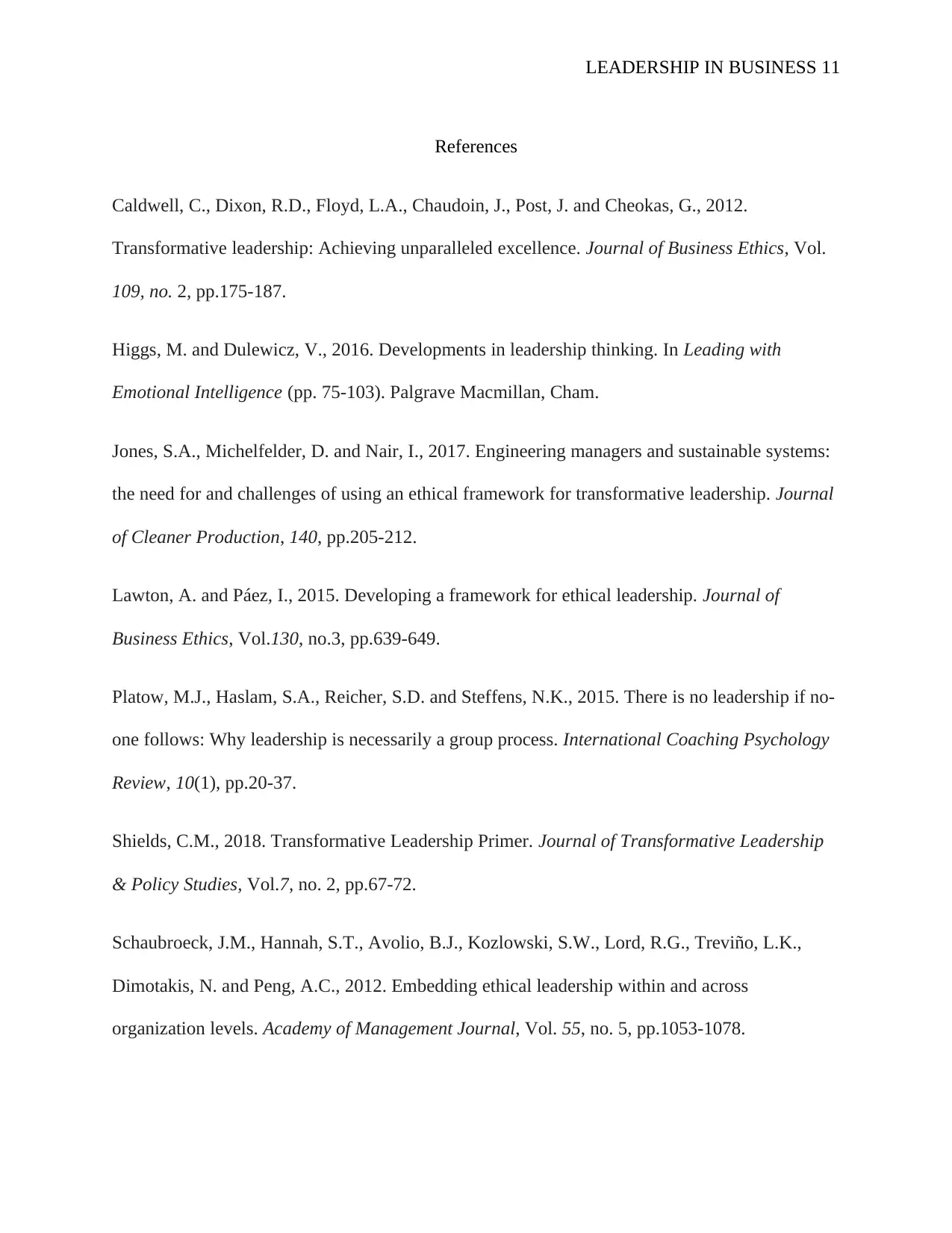
LEADERSHIP IN BUSINESS 11
References
Caldwell, C., Dixon, R.D., Floyd, L.A., Chaudoin, J., Post, J. and Cheokas, G., 2012.
Transformative leadership: Achieving unparalleled excellence. Journal of Business Ethics, Vol.
109, no. 2, pp.175-187.
Higgs, M. and Dulewicz, V., 2016. Developments in leadership thinking. In Leading with
Emotional Intelligence (pp. 75-103). Palgrave Macmillan, Cham.
Jones, S.A., Michelfelder, D. and Nair, I., 2017. Engineering managers and sustainable systems:
the need for and challenges of using an ethical framework for transformative leadership. Journal
of Cleaner Production, 140, pp.205-212.
Lawton, A. and Páez, I., 2015. Developing a framework for ethical leadership. Journal of
Business Ethics, Vol.130, no.3, pp.639-649.
Platow, M.J., Haslam, S.A., Reicher, S.D. and Steffens, N.K., 2015. There is no leadership if no-
one follows: Why leadership is necessarily a group process. International Coaching Psychology
Review, 10(1), pp.20-37.
Shields, C.M., 2018. Transformative Leadership Primer. Journal of Transformative Leadership
& Policy Studies, Vol.7, no. 2, pp.67-72.
Schaubroeck, J.M., Hannah, S.T., Avolio, B.J., Kozlowski, S.W., Lord, R.G., Treviño, L.K.,
Dimotakis, N. and Peng, A.C., 2012. Embedding ethical leadership within and across
organization levels. Academy of Management Journal, Vol. 55, no. 5, pp.1053-1078.
References
Caldwell, C., Dixon, R.D., Floyd, L.A., Chaudoin, J., Post, J. and Cheokas, G., 2012.
Transformative leadership: Achieving unparalleled excellence. Journal of Business Ethics, Vol.
109, no. 2, pp.175-187.
Higgs, M. and Dulewicz, V., 2016. Developments in leadership thinking. In Leading with
Emotional Intelligence (pp. 75-103). Palgrave Macmillan, Cham.
Jones, S.A., Michelfelder, D. and Nair, I., 2017. Engineering managers and sustainable systems:
the need for and challenges of using an ethical framework for transformative leadership. Journal
of Cleaner Production, 140, pp.205-212.
Lawton, A. and Páez, I., 2015. Developing a framework for ethical leadership. Journal of
Business Ethics, Vol.130, no.3, pp.639-649.
Platow, M.J., Haslam, S.A., Reicher, S.D. and Steffens, N.K., 2015. There is no leadership if no-
one follows: Why leadership is necessarily a group process. International Coaching Psychology
Review, 10(1), pp.20-37.
Shields, C.M., 2018. Transformative Leadership Primer. Journal of Transformative Leadership
& Policy Studies, Vol.7, no. 2, pp.67-72.
Schaubroeck, J.M., Hannah, S.T., Avolio, B.J., Kozlowski, S.W., Lord, R.G., Treviño, L.K.,
Dimotakis, N. and Peng, A.C., 2012. Embedding ethical leadership within and across
organization levels. Academy of Management Journal, Vol. 55, no. 5, pp.1053-1078.

LEADERSHIP IN BUSINESS 12
Sy, T., Horton, C. and Riggio, R., 2018. Charismatic leadership: Eliciting and channeling
follower emotions. The Leadership Quarterly, Vol. 29, no.1, pp.58-69.
Sy, T., Horton, C. and Riggio, R., 2018. Charismatic leadership: Eliciting and channeling
follower emotions. The Leadership Quarterly, Vol. 29, no.1, pp.58-69.
⊘ This is a preview!⊘
Do you want full access?
Subscribe today to unlock all pages.

Trusted by 1+ million students worldwide
1 out of 12
Related Documents
Your All-in-One AI-Powered Toolkit for Academic Success.
+13062052269
info@desklib.com
Available 24*7 on WhatsApp / Email
![[object Object]](/_next/static/media/star-bottom.7253800d.svg)
Unlock your academic potential
Copyright © 2020–2025 A2Z Services. All Rights Reserved. Developed and managed by ZUCOL.





